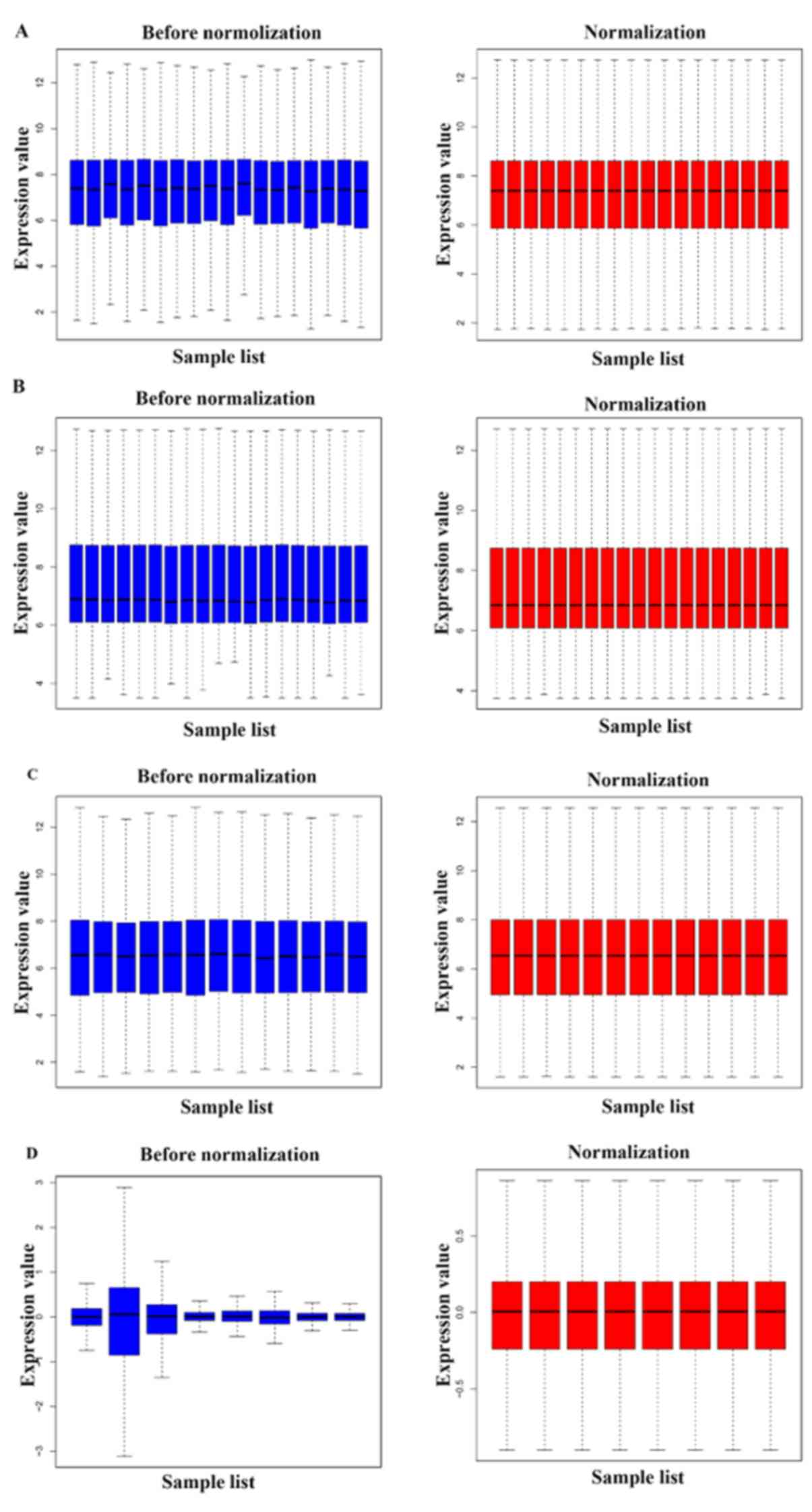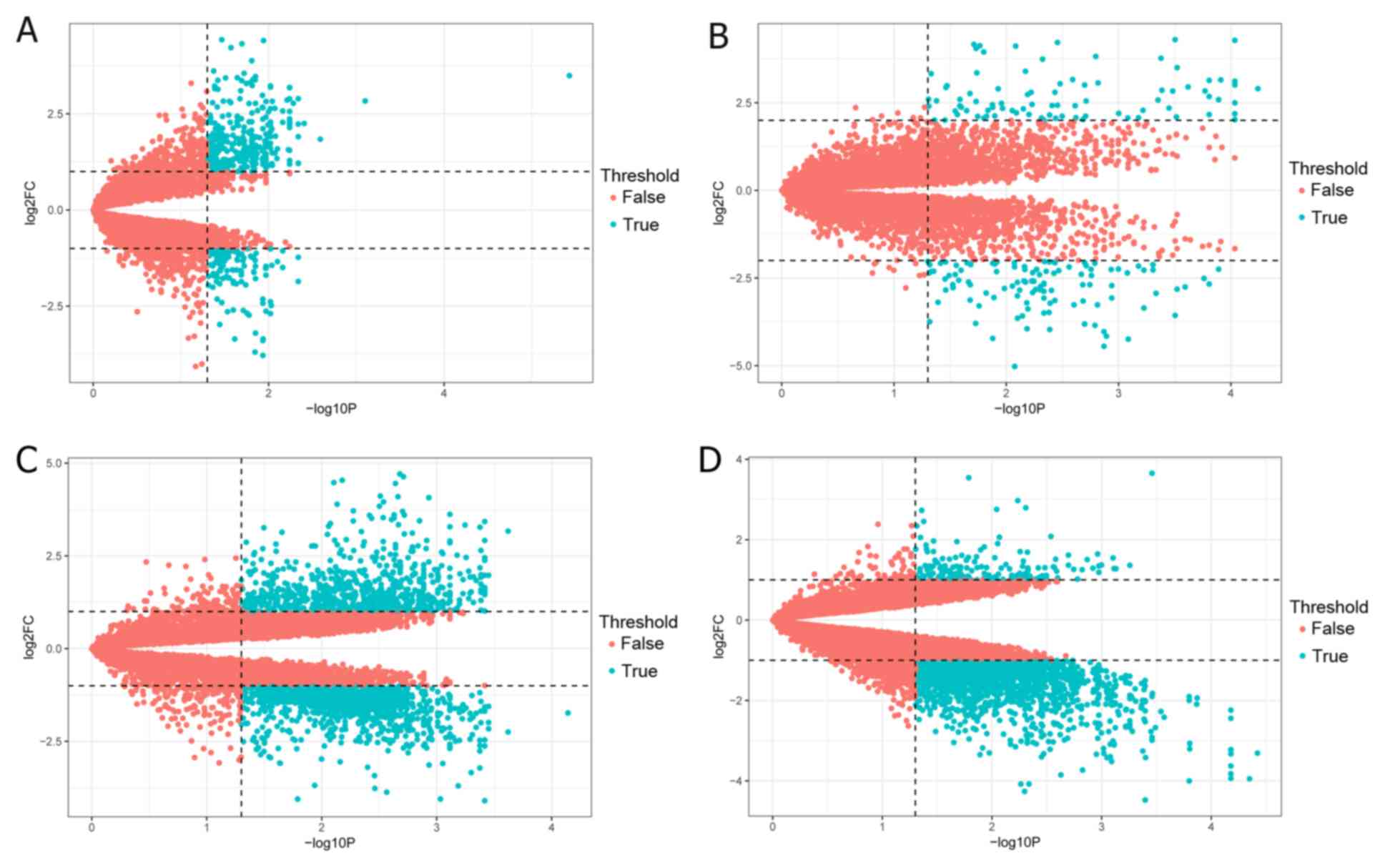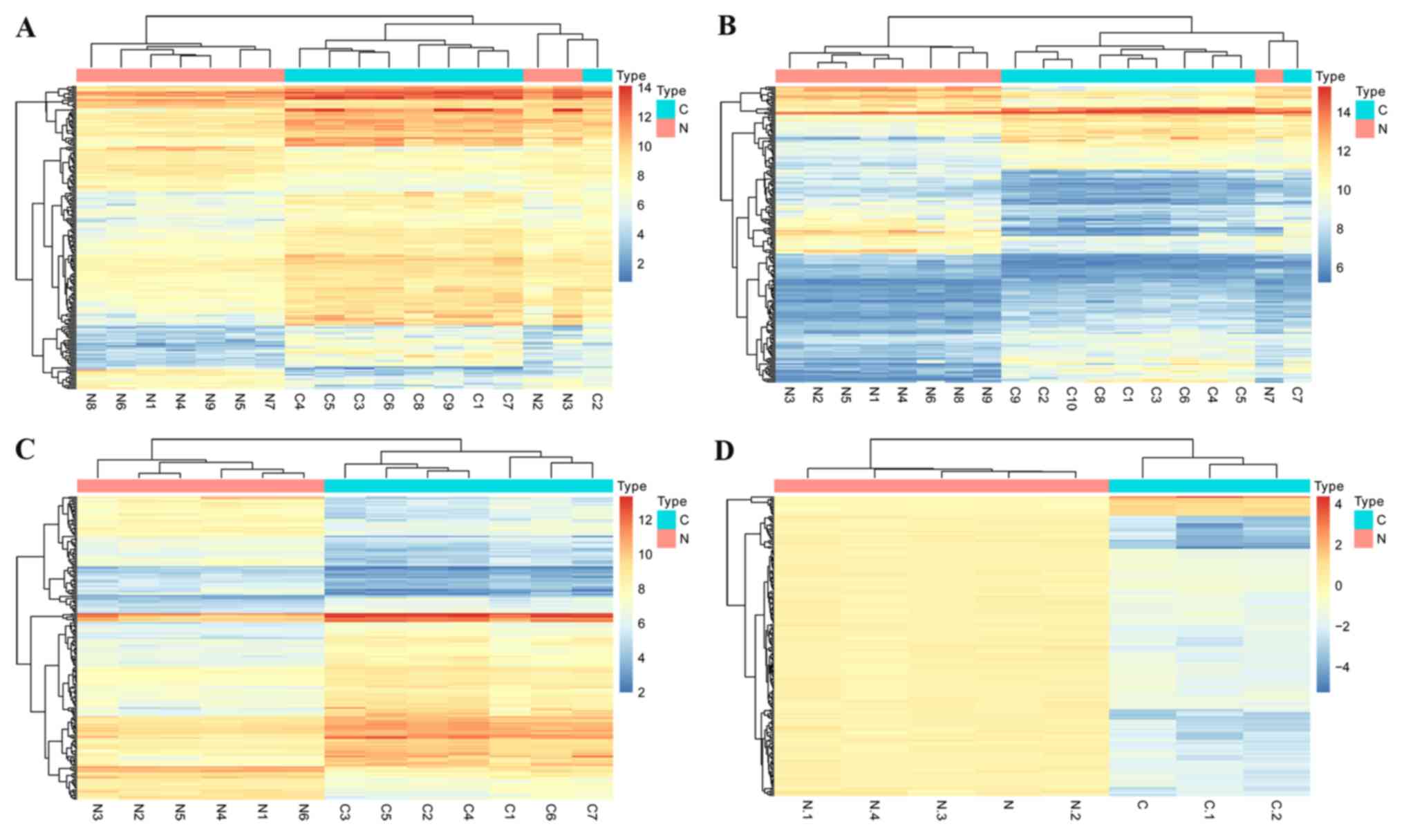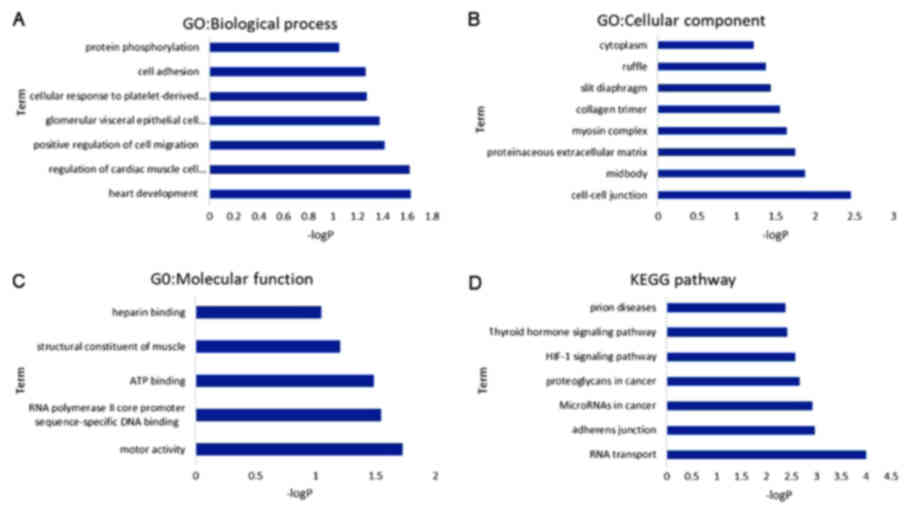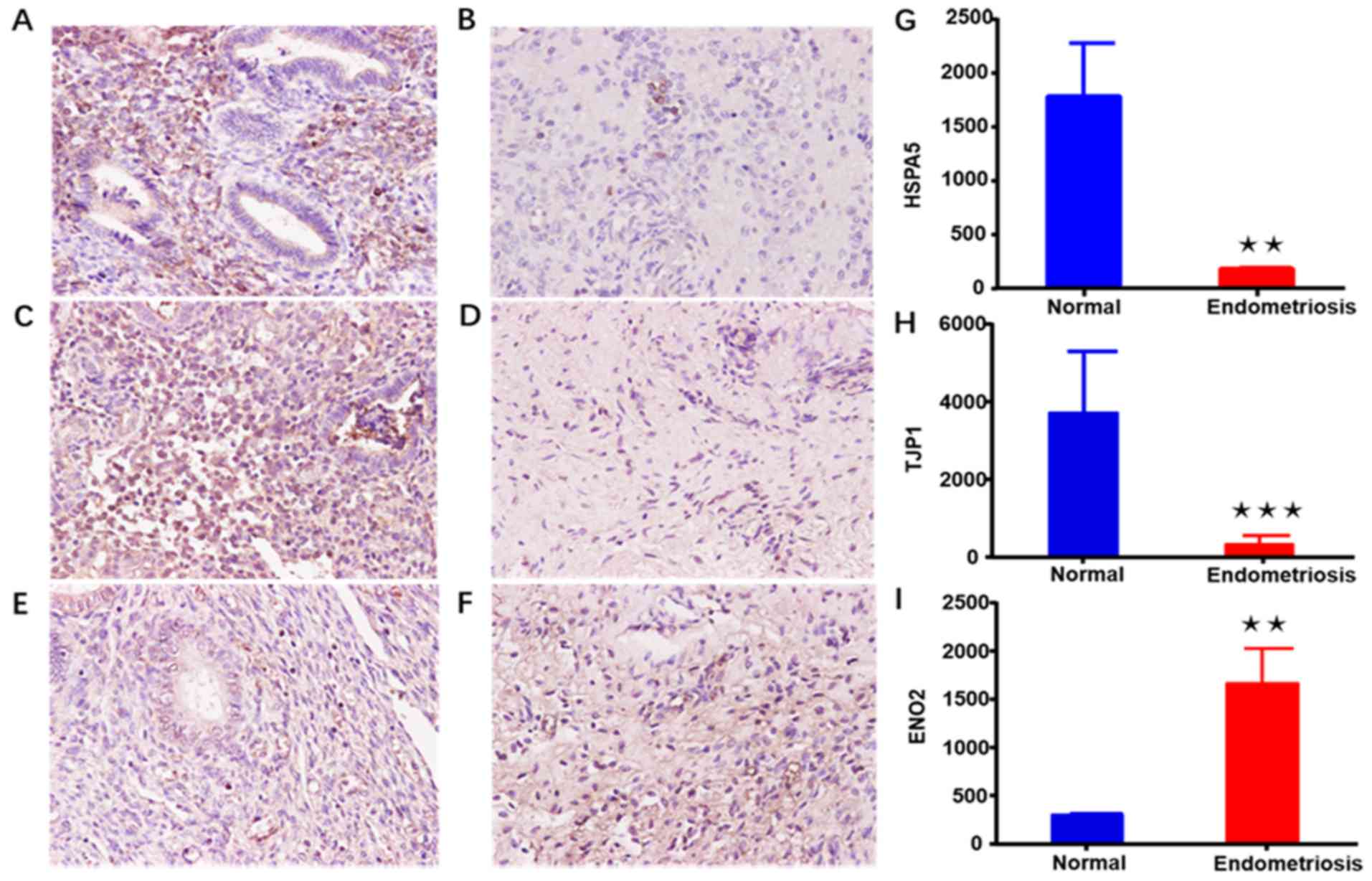Identification of differentially expressed genes and signaling pathways involved in endometriosis by integrated bioinformatics analysis
- Authors:
- Published online on: November 18, 2019 https://doi.org/10.3892/etm.2019.8214
- Pages: 264-272
-
Copyright: © Dai et al. This is an open access article distributed under the terms of Creative Commons Attribution License.
Abstract
Introduction
Endometriosis, a benign disease with malignant properties, is defined by the presence of active endometrial cells outside the uterus, including in the pelvis, abdominal cavity, intestines, rectovaginal septum, abdominal wall and myometrium (also known as adenomyosis) (1,2). Patients afflicted with endometriosis are associated with higher occurrences of anxiety and depression (3). In addition, women with endometriosis are more likely to experience non-menstrual pelvic pain (36.7% vs. 14.3%), dyspareunia (29.5% vs. 13.4%) and infertility (11.6% vs. 3.4%) compared with women without endometriosis (4). The current gold standard treatments for endometriosis are surgical resection and hormone suppression; however, none of these therapies are ideal due to their various side effects and high recurrence rates (5). In order to improve the treatment strategies, it is important to study the underlying mechanisms involved in disease development and progression. In addition, identifying reliable molecular markers can aid in the diagnosis and treatment of endometriosis.
The upregulation and downregulation of genes associated with disease susceptibility serves an important role in the progression of endometriosis (6). With the development of next-generation sequencing, gene expression microarrays have been widely performed to identify the differentially expressed genes (DEGs) that may be involved in the development and progression of endometriosis (5,7). However, due to the different sample size, technology detection platforms and inconsistent data processing methods across different studies, the DEGs identified in previous studies are inconsistent or even contradictory. Thus, there are certain limitations in using a single gene expression profile. Integrated bioinformatics analysis has emerged as a promising tool for exploring the molecular markers and signaling pathways involved in diseases, and has previously been applied to study ovarian cancer (8), breast cancer (9) and non-small cell lung cancer (10).
In the present study, four microarray expression datasets, namely GSE11691 (11), GSE23339 (12), GSE25628 (13) and GSE78851 (14) were downloaded from the Gene Expression Omnibus (GEO) database of the National Center for Biotechnology Information. A total of 58 samples, including 27 cases of endometriosis and 31 normal samples, were included in the present study. Firstly, the gene expression profiles were normalized, and the DEGs were then identified using the limma package function of R software. Subsequently, Gene Ontology (GO) enrichment analysis of DEGs was performed on Database for Annotation, Visualization and Integrated Discovery (DAVID), while the Kyoto Encyclopedia of Genes and Genomes (KEGG) pathways were analyzed via the KOBAS online analysis database. Finally, a protein-protein interaction (PPI) network was constructed using the STRING online database. Cytoscape software was applied for further visualization. The current study identified key signaling pathways and potential candidate genes involved in the development of endometriosis, which may facilitate a better understanding of the underlying molecular mechanisms and provide effective targets for the diagnosis and treatment of this disease.
Materials and methods
Gene expression data
The keyword ‘endometriosis’ was used to search the GEO database (http://www.ncbi.nlm.nih.gov/geo), and the gene expression profiles of GSE11691 (11), GSE23339 (12), GSE25628 (13) and GSE78851 (14) were downloaded. The dataset GSE11691, based on the platform GPL96 [HG-U133A] Affymetrix Human Genome U133A Array (Affymetrix; Thermo Fisher Scientific, Inc., Waltham, MA, USA), included 9 endometriosis tissues and 9 normal endometrial tissue samples. The platform for GSE23339 was GPL6102 (Illumina Human-6 v2.0 expression beadchip; Illumina, Inc., San Diego, CA, USA), including 10 endometrioma samples and 9 control endometrium specimens. GSE25628 included 7 samples of ectopic endometrioma and 6 samples of normal endometrial tissue, and its platform was GPL571 [HG-U133A_2] Affymetrix Human Genome U133A 2.0 Array (Affymetrix; Thermo Fisher Scientific, Inc.). The platform for GSE78851, consisting of 3 tissues from patients with adenomyosis and 5 normal tissues, was GPL6244 [HuGene-1_0-st] Affymetrix Human Gene 1.0 ST Array [transcript (gene) version] (Affymetrix; Thermo Fisher Scientific, Inc.). The platform and series matrix files were downloaded as CSV files. The dataset information is displayed in Table I.
Data processing
The gene IDs within each gene expression profile was converted into a gene symbol, and then the data were log2 transformed and normalized using R 5.3.1 (https://www.r-project.org/). DEGs between endometriosis and non-endometriosis samples were screened out under the thresholds of |log2 fold change (FC)|>1 and P<0.05 using the limma package in the Bioconductor 3.9 tool (http://www.bioconductor.org/packages/release/bioc/html/limma.html). The volcano map of the DEGs and the heatmap of the top 200 DEGs in each microarray datasets were obtained using R.
Integration of microarray data
SangerBox 1.0.8 (http://sangerbox.com/) is a computerized and powerful software for biological information analysis, and is used as a visualization tool. The robust rank aggregation (RRA) method can be applied as a useful and general solution for gene list integration and meta-analysis in an unbiased manner, using a probabilistic model to make the algorithm parameter free and robust to outliers, noise and errors, and to assign a significance score to each gene (15). The RRA method can rank each item in each list and compare this ranking with the baseline case where all preference lists are randomly ordered. The P-value can represent the rank location, with a smaller P-value indicating a higher gene rank. In the present study, RRA in SangerBox was performed for comprehensive sorting of DEGs in the four gene expression profiles. P<0.05 was set as the threshold, and DEGs that were inconsistent across the four data sets were excluded.
Pathway enrichment analysis
GO analysis (16), which is composed of biological process (BP), cellular compartment (CC) and molecular function (MF) terms, is a common method for large-scale genomic data function annotation. In order to better understand the mechanism of DEGs involved in the development of endometriosis, GO and KEGG pathway enrichment analyses were performed using the DAVID 6.8 (https://david.ncifcrf.gov/) and the KOBAS 3.0 (http://kobas.cbi.pku.edu.cn/) online analysis tool. P<0.05 was considered to indicate a statistically significant difference in these analyses.
PPI network construction
The STRING database (http://string-db.org/) was used to identify the interacting protein pairs among DEGs with the criterion of combined score of ≥0.4. Upon removal of the isolated and partially connected nodes, a complex network of DEGs was constructed. The file of STRING interactions was downloaded and visualized with Cytoscape 3.7.0 (https://cytoscape.org/).
Immunohistochemistry
For immunohistochemical analysis, archival samples of normal endometrial and endometriosis specimens were used. The samples had been collected between May 2018 and December 2018 from patients that underwent surgery at Renmin Hospital of Wuhan University (Wuhan, China). The age of the females from which these samples were collected ranged between 20 and 40 years old. The present study was approved by the Ethics Committee of Renmin Hospital of Wuhan University, Patients and their families signed an informed consent form in advance. In short, six normal endometrial and six endometriosis specimens were confirmed by a pathologist. The tissue samples were cut into sections of 3 µm in thickness and 3 mm in diameter. Once the samples had been dewaxed, hydrated and treated with sodium citrate (pH=6), hydrogen peroxide was used to block any endogenous peroxidase activity. Immunohistochemical staining was conducted with a rabbit polyclonal primary antibody against HSPA5 (1:150; cat. no. ab108615; Abcam, Cambridge, MA, USA), TJP1 (1:150; cat. no. 21773-1-AP; Wuhan Sanying Biotechnology, Wuhan, China) and ENO2 (1:100; cat. no. ab79757; Abcam) at 4°C overnight. Subsequently, the samples were incubated with a horseradish peroxidase-conjugated goat anti-rabbit secondary antibody (1:200; cat. no. AS-1107; Aspen) at 37°C for 50 min, and a 3,3′-diaminobenzidine solution and hematoxylin were then used for staining and counterstaining at room temperate for 1 min. The integrated option density was analyzed using the ImageJ software (version 1.4.6; National Institutes of Health).
Results
Differential expression profiles
The gene expression profiles of the datasets GSE11691, GSE23339, GSE25628 and GSE78851 were normalized, as shown in Fig. 1. According to the criteria of |log2FC|>1 and P<0.05, a total of 903 DEGs were identified in GSE11691 using the limma R package, including 575 upregulated and 328 downregulated genes. A total of 1,139 DEGs were identified from the GSE23339 dataset, including 608 upregulated and 531 downregulated genes. Additionally, 1,731 DEGs were identified from the GSE25628 dataset, consisting of 708 upregulated and 1,023 downregulated genes, while there was a total of 2,118 DEGs in the GSE78851 dataset, including 221 upregulated and 1,897 downregulated genes. Subsequently, the volcano plots for the identified DEGs and the cluster heatmaps of the top 200 DEGs in each dataset were constructed, and are presented in Figs. 2 and 3, respectively.
Identification of DEGs in endometriosis using integrated bioinformatics analysis
The RRA method assumes that each gene in each dataset is randomly arranged, which is widely used in integrated bioinformatics analysis (17,18). Through rank analysis (corrected P-value of <0.05), 275 integrated DEGs were identified. In order to obtain more reliable DEGs, genes with inconsistent upregulation and downregulation in the expression profiles were deleted. In total, 103 integrated genes were identified, including 47 upregulated and 56 downregulated genes (Table II). The top 20 upregulated and downregulated genes were represented on heatmaps using Sanger Box software, as shown in Fig. 4.
GO functional enrichment analysis
The GO functional analysis was divided into the BP, MF and CC categories. As displayed in Fig. 5, the DEGs were mainly enriched in cell adhesion, cell migration, cell-cell junction and heparin binding in the GO function annotation. Furthermore, according to the KEGG pathway analysis, the DEGs were mainly involved in adherens junction and hypoxia-inducible factor (HIF)-1 signaling.
PPI network analysis
A PPI network was subsequently constructed, which consisted of 54 nodes (proteins) and 62 edges (interactions), as shown in Fig. 6. The genes showing the most significant interaction in the network were PIK3R1, ERBB3, MRPS31, HSPA5, ZFPM2, NUP88, SUZ12, MRPL39, HSPA4, GATA6, NUPL2, and EP300.
Immunohistochemistry
To further investigate whether the expression of the identified genes in endometriosis tissues was consistent with the bioinformatic analysis results, the expression of certain genes in each pathway was randomly verified. HSPA5, ENO2 and TJP1 are associated with cell migration, adherens junction and the HIF-1 signaling pathway, respectively. As shown in Fig. 7, the findings of immunohistochemical analysis verified that the expression levels of HSPA5 and TJP1 were evidently reduced in endometriosis as compared with that in normal tissues. However, ENO2 was significantly upregulated in endometriosis, which was consistent with the bioinformatics results.
Discussion
It is estimated that there are 176 million women with endometriosis worldwide, and this condition seriously affects 10% of women of reproductive age (19). Chronic pelvic pain and infertility cause great physical pain and mental distress to women with endometriosis and their partners, greatly reducing the family happiness index and increasing the domestic burden (20). Accumulating evidence suggests that the endometrium of patients with endometriosis exhibits abnormal molecular expression, which gives the tissue the ability to implant, invade and develop into endometriosis lesions (21,22). In order to identify more stable and reliable molecular markers, the present study mapped out the genetic alterations that may be involved in the development of endometriosis by integrated bioinformatics analysis.
Four gene expression profile datasets from different groups were integrated in the present study, and R software and bioinformatics analysis were used to analyze these datasets. A total of 103 DEGs were identified using the RRA analysis method, including 47 upregulated and 56 downregulated genes. Furthermore, through GO and KEGG analyses, these DEGs were found to be closely associated with cell migration, adherens junction and the HIF-1 signaling pathway. The results revealed that the DEGs associated with cell migration in endometriosis were PIK3R1, PODXL, HSPA5 and LRRC15, while the genes IQGAP1, TJP1 and EP300 were involved in adherens junction. Notably, the DEGs EP300, ENO2 and PIK3R1 were mainly associated with the HIF-1 signaling pathway.
The most widely accepted theory for the development of endometriosis is implantation and invasiveness. Accumulating studies have indicated that the degradation of extracellular matrix and the alteration of gene expression serve critical roles in the pathophysiological processes of endometriosis (23,24). In addition, PI3K/Akt signaling has been reported to be involved in these processes (25). Rai and Shivaji indicated that DJ-1 regulated cell proliferation, migration and invasion in endometriotic epithelial cells via the PI3K/Akt signaling pathway. In the present study, the findings demonstrated that the gene PIK3R1 was downregulated and may be involved in cell migration (26). In addition, PODXL, HSPA5 and LRRC15 may also have potential value in this process.
Intercellular junctions (including tight junctions and adherens junctions) play a critical role in the endometrium. The development of endometriosis is accompanied with changes in cell-cell tight junctions (27). Extensive research has demonstrated that claudin-3, claudin-4, ZO-3, E-cadherin and α-catenin are downregulated in the ectopic endometrium as compared with their expression in the corresponding eutopic endometrium (28–30). In the present study, integrated bioinformatics analysis revealed that the expression levels of genes associated with the adherens junction pathway, namely IQGAP1, TJP and EP300, were significantly reduced in endometriosis.
In the last decade, researchers have indicated that the expression of HIF-1α was higher in ectopic endometriosis tissue as compared with that in eutopic tissue (31,32). Furthermore, hypoxia can induced the invasion of endometrial stromal cells and promoted the endometriosis-associated angiogenesis (33,34). Additionally, the expression of HIF-1α in the serum was reported to be proportional to the stage of endometriosis and the severity of pain (32). Indeed, bioinformatics analysis in the present study deonmonstrated that the expression of genes associated with HIF-1α, such as ENO2, was upregulated in endometriosis.
In conclusion, the present study revealed that cell migration, adherens junction and the HIF-1 signaling pathway may be involved in the development of endometriosis via integrated bioinformatics analysis. In addition, these identified DEGs may be of clinical significance for the diagnosis and treatment of the endometriosis. However, as the present study is solely based on data analysis and experimental verification, further studies with larger samples and clinical trials are required to confirm the function of the identified genes in endometriosis.
Acknowledgements
Not applicable.
Funding
The present study was supported by the China Graduate School of Graduate Education Fund Project (grant. no. B2-YX20180302-19) and the Wuhan University People's Hospital Guidance Fund Project (grant. no. RMYD2018M05).
Availability of data and materials
All data generated or analyzed during this study are included in the published article.
Authors' contributions
FFD and AYB conceived and designed the research. XLP, SX and LZ collected the data. YQW, MQY and DYY conducted literature research. FFD, ZHZ and SYL analyzed the database, and prepared the diagrams. FFD drafted the manuscript, BL collected the samples, YXC revised the article and provided funding. All authors read and approved the final manuscript.
Ethics approval and consent to participate
This study was approved by the Ethics Committee of Renmin Hospital of Wuhan University (Hubei, China). Patients who participated in this research had complete clinical data. The patients and their families signed an informed consent form in advance.
Patient consent for publication
Not applicable.
Competing interests
The authors declare that they have no competing interests.
References
|
Jenkins S, Olive DL and Haney AF: Endometriosis: Pathogenetic implications of the anatomic distribution. Obstet Gynecol. 67:335–338. 1986.PubMed/NCBI | |
|
Krawczyk N, Banys-Paluchowski M, Schmidt D, Ulrich U and Fehm T: Endometriosis-associated malignancy. Geburtshilfe Frauenheilkd. 76:176–181. 2016. View Article : Google Scholar : PubMed/NCBI | |
|
Laganà AS, La Rosa VL, Rapisarda AMC, Valenti G, Sapia F, Chiofalo B, Rossetti D, Ban Frangež H, Vrtačnik Bokal E and Vitale SG: Anxiety and depression in patients with endometriosis: Impact and management challenges. Int J Womens Health. 9:323–330. 2017. View Article : Google Scholar : PubMed/NCBI | |
|
Fuldeore MJ and Soliman AM: Prevalence and symptomatic burden of diagnosed endometriosis in the United States: National estimates from a cross-sectional survey of 59,411 women. Gynecol Obstet Invest. 82:453–461. 2017. View Article : Google Scholar : PubMed/NCBI | |
|
Liu F, Lv X, Yu H, Xu P, Ma R and Zou K: In search of key genes associated with endometriosis using bioinformatics approach. Eur J Obstet Gynecol Reprod Biol. 194:119–124. 2015. View Article : Google Scholar : PubMed/NCBI | |
|
Kobayashi H, Imanaka S, Nakamura H and Tsuji A: Understanding the role of epigenomic, genomic and genetic alterations in the development of endometriosis (review). Mol Med Rep. 9:1483–1505. 2014. View Article : Google Scholar : PubMed/NCBI | |
|
Sha G, Wu D, Zhang L, Chen X, Lei M, Sun H, Lin S and Lang J: Differentially expressed genes in human endometrial endothelial cells derived from eutopic endometrium of patients with endometriosis compared with those from patients without endometriosis. Hum Reprod. 22:3159–3169. 2007. View Article : Google Scholar : PubMed/NCBI | |
|
Yang X, Zhu S, Li L, Zhang L, Xian S, Wang Y and Cheng Y: Identification of differentially expressed genes and signaling pathways in ovarian cancer by integrated bioinformatics analysis. Onco Targets Ther. 11:1457–1474. 2018. View Article : Google Scholar : PubMed/NCBI | |
|
Wang Y, Zhang Y, Huang Q and Li C: Integrated bioinformatics analysis reveals key candidate genes and pathways in breast cancer. Mol Med Rep. 17:8091–8100. 2018.PubMed/NCBI | |
|
Ni M, Liu X, Wu J, Zhang D, Tian J, Wang T, Liu S, Meng Z, Wang K, Duan X, et al: Identification of candidate biomarkers correlated with the pathogenesis and prognosis of non-small cell lung cancer via integrated bioinformatics analysis. Front Genet. 9:4692018. View Article : Google Scholar : PubMed/NCBI | |
|
Hull ML, Escareno CR, Godsland JM, Doig JR, Johnson CM, Phillips SC, Smith SK, Tavaré S, Print CG and Charnock-Jones DS: Endometrial-peritoneal interactions during endometriotic lesion establishment. Am J Pathol. 173:700–715. 2008. View Article : Google Scholar : PubMed/NCBI | |
|
Hawkins SM, Creighton CJ, Han DY, Zariff A, Anderson ML, Gunaratne PH and Matzuk MM: Functional microRNA involved in endometriosis. Mol Endocrinol. 25:821–832. 2011. View Article : Google Scholar : PubMed/NCBI | |
|
Crispi S, Piccolo MT, D'Avino A, Donizetti A, Viceconte R, Spyrou M, Calogero RA, Baldi A and Signorile PG: Transcriptional profiling of endometriosis tissues identifies genes related to organogenesis defects. J Cell Physiol. 228:1927–1934. 2013. View Article : Google Scholar : PubMed/NCBI | |
|
Herndon CN, Aghajanova L, Balayan S, Erikson D, Barragan F, Goldfien G, Vo KC, Hawkins S and Giudice LC: Global transcriptome abnormalities of the eutopic endometrium from women with adenomyosis. Reprod Sci. 23:1289–1303. 2016. View Article : Google Scholar : PubMed/NCBI | |
|
Kolde R, Laur S, Adler P and Vilo J: Robust rank aggregation for gene list integration and meta-analysis. Bioinformatics. 28:573–580. 2012. View Article : Google Scholar : PubMed/NCBI | |
|
Ashburner M, Ball CA, Blake JA, Botstein D, Butler H, Cherry JM, Davis AP, Dolinski K, Dwight SS, Eppig JT, et al: Gene ontology: Tool for the unification of biology. The gene ontology consortium. Nat Genet. 25:25–29. 2000. View Article : Google Scholar : PubMed/NCBI | |
|
Xiong DD, Dang YW, Lin P, Wen DY, He RQ, Luo DZ, Feng ZB and Chen G: A circRNA-miRNA-mRNA network identification for exploring underlying pathogenesis and therapy strategy of hepatocellular carcinoma. J Transl Med. 16:2202018. View Article : Google Scholar : PubMed/NCBI | |
|
Gao X, Chen Y, Chen M, Wang S, Wen X and Zhang S: Identification of key candidate genes and biological pathways in bladder cancer. PeerJ. 6:e60362018. View Article : Google Scholar : PubMed/NCBI | |
|
Rogers PA, D'Hooghe TM, Fazleabas A, Gargett CE, Giudice LC, Montgomery GW, Rombauts L, Salamonsen LA and Zondervan KT: Priorities for endometriosis research: Recommendations from an international consensus workshop. Reprod Sci. 16:335–346. 2009. View Article : Google Scholar : PubMed/NCBI | |
|
Simoens S, Dunselman G, Dirksen C, Hummelshoj L, Bokor A, Brandes I, Brodszky V, Canis M, Colombo GL, DeLeire T, et al: The burden of endometriosis: Costs and quality of life of women with endometriosis and treated in referral centres. Hum Reprod. 27:1292–1299. 2012. View Article : Google Scholar : PubMed/NCBI | |
|
Mehasseb MK, Panchal R, Taylor AH, Brown L, Bell SC and Habiba M: Estrogen and progesterone receptor isoform distribution through the menstrual cycle in uteri with and without adenomyosis. Fertil Steril. 95:2228–2235, 2235 e1. 2011. View Article : Google Scholar : PubMed/NCBI | |
|
Aghajanova L, Velarde MC and Giudice LC: Altered gene expression profiling in endometrium: Evidence for progesterone resistance. Semin Reprod Med. 28:51–58. 2010. View Article : Google Scholar : PubMed/NCBI | |
|
Kobayashi H: Invasive capacity of heterotopic endometrium. Gynecol Obstet Invest. 50 (Suppl 1):S26–S32. 2000. View Article : Google Scholar | |
|
Saare M, Krigul KL, Laisk-Podar T, Ponandai-Srinivasan S, Rahmioglu N, Lalit Kumar PG, Zondervan K, Salumets A and Peters M: DNA methylation alterations-potential cause of endometriosis pathogenesis or a reflection of tissue heterogeneity? Biol Reprod. 99:273–282. 2018. View Article : Google Scholar : PubMed/NCBI | |
|
Zheng T and Yang J: Differential expression of EWI-2 in endometriosis, its functional role and underlying molecular mechanisms. J Obstet Gynaecol Res. 43:1180–1188. 2017. View Article : Google Scholar : PubMed/NCBI | |
|
Rai P and Shivaji S: The role of DJ-1 in the pathogenesis of endometriosis. PLoS One. 6:e180742011. View Article : Google Scholar : PubMed/NCBI | |
|
Grund S and Grümmer R: Direct cell-cell interactions in the endometrium and in endometrial pathophysiology. Int J Mol Sci. 19(pii): E22272018. View Article : Google Scholar : PubMed/NCBI | |
|
Pan XY, Li X, Weng ZP and Wang B: Altered expression of claudin-3 and claudin-4 in ectopic endometrium of women with endometriosis. Fertil Steril. 91:1692–1699. 2009. View Article : Google Scholar : PubMed/NCBI | |
|
Sohler F, Sommer A, Wachter DL, Agaimy A, Fischer OM, Renner SP, Burghaus S, Fasching PA, Beckmann MW, Fuhrmann U, et al: Tissue remodeling and nonendometrium-like menstrual cycling are hallmarks of peritoneal endometriosis lesions. Reprod Sci. 20:85–102. 2013. View Article : Google Scholar : PubMed/NCBI | |
|
Shaco-Levy R, Sharabi S, Benharroch D, Piura B and Sion-Vardy N: Matrix metalloproteinases 2 and 9, E-cadherin, and beta-catenin expression in endometriosis, low-grade endometrial carcinoma and non-neoplastic eutopic endometrium. Eur J Obstet Gynecol Reprod Biol. 139:226–232. 2008. View Article : Google Scholar : PubMed/NCBI | |
|
Zhan L, Wang W, Zhang Y, Song E, Fan Y and Wei B: Hypoxia-inducible factor-1alpha: A promising therapeutic target in endometriosis. Biochimie. 123:130–137. 2016. View Article : Google Scholar : PubMed/NCBI | |
|
Zhang F, Liu XL, Wang W, Dong HL, Xia YF, Ruan LP and Liu LP: Expression of MMIF, HIF-1α and VEGF in serum and endometrial tissues of patients with endometriosis. Curr Med Sci. 38:499–504. 2018. View Article : Google Scholar : PubMed/NCBI | |
|
Xiong W, Zhang L, Xiong Y, Liu H and Liu Y: Hypoxia promotes invasion of endometrial stromal cells via hypoxia-inducible factor 1α upregulation-mediated β-catenin activation in endometriosis. Reprod Sci. 23:531–541. 2016. View Article : Google Scholar : PubMed/NCBI | |
|
Becker CM, Rohwer N, Funakoshi T, Cramer T, Bernhardt W, Birsner A, Folkman J and D'Amato RJ: 2-methoxyestradiol inhibits hypoxia-inducible factor-1{alpha} and suppresses growth of lesions in a mouse model of endometriosis. Am J Pathol. 172:534–544. 2008. View Article : Google Scholar : PubMed/NCBI |



